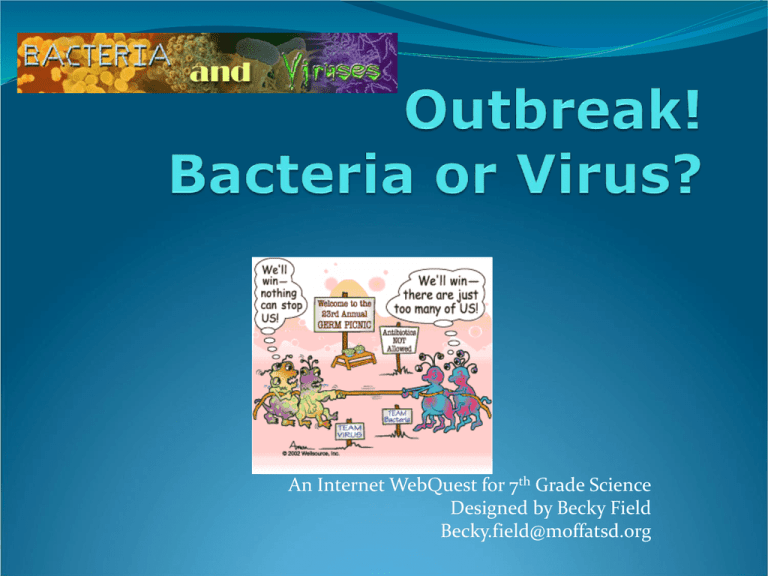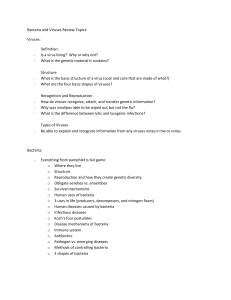Outbreak! Bacteria or Virus?
advertisement

An Internet WebQuest for 7th Grade Science Designed by Becky Field Becky.field@moffatsd.org Introduction Have you ever gotten sick and went to the doctor only to be told you would just have to “tough it out” because the symptoms were most likely caused by a virus? How about the time you had a high fever and were sure a virus caused it but you went to the doctor anyway and found out your symptoms were caused by bacteria? What’s the difference between a viral illness and a bacterial illness? Can a virus be killed? Are bacteria alive? How does the doctor decide to treat patients with viral or bacterial caused illnesses? In this WebQuest you will have the opportunity to research each of these questions as consultants for the CDC (Centers for Disease Control and Prevention). You have just received a phone call from the CDC asking for your help. They need you to fly to a village in Africa to investigate an outbreak of a strange disease. Your mission will be to determine if a bacteria or a virus caused the disease. You will need to prepare a PowerPoint presentation to inform the CDC what you have learned about the differences between bacteria and viruses. You will then make a recommendation on whether the patients and rest of the village should be quarantined, vaccinated or treated with antibiotics. Good Luck! The Disease The specifics of this particular mysterious disease are: the patients start symptoms one to three days from exposure, the patients develop a nonproductive cough, headaches, aches and pains, extreme exhaustion, and an extremely high fever and chills that lasts for 3-4 days. There have been some fatalities especially in the elderly and extremely young. Antibiotics have not been helpful in the treatment of the disease. Incubation period of the disease is one to three days. Most patients have similar symptoms but recovery time varies from patient to patient depending on overall health and age. The Task You must learn as much as you can about the differences between bacteria and viruses so that you can prepare a PowerPoint presentation that will persuade the CDC to follow your suggestions. Include the following in your presentation: a comparison of bacteria and viruses in the areas of: living vs. nonliving, size, how they reproduce, basic symptoms of diseases caused by bacteria or viruses, a list of some diseases caused by bacteria and/or viruses, treatments/cures or preventions and a recommendation of how to treat the patients with the disease. Phase 1 Background In this WebQuest you will be working to answer every part of the Quest. You will explore WebPages from people all over the world who care about Outbreak! Because these are real WebPages we're tapping into, not things made just for schools; the reading level might challenge you. Feel free to use the online dictionary or one in your computer lab. You'll begin by getting some background information before deciding what course of action to take. 1. Explore the websites below to find the information you need to understand bacteria and viruses. 2. Read through the files that are linked.. Use the WebQuest worksheet to keep track of the information necessary to complete the Task. While you are looking at the files on the computer, copy sections you feel are important by dragging the mouse across the passage and copying / pasting it into a Word/ Apple Works document. 3. Note: Remember to write down or copy/paste the URL of the file you take the passage from so you can quickly go back to it if you need to prove your point. You may choose to copy diagrams, pictures or animations that you may want to use in your presentation. Basic differences between bacteria and viruses (You will need to highlight each website and copy and paste it into the internet.) http://www.beyondbooks.com/lif72/2.asp http://www.mansfieldct.org/schools/mms/staff/hand/Immuneb acteriavsviruses.htm http://www.ehow.com/about_5097832_virus-vs-bacteria- symptoms.html http://www.diffen.com/difference/Bacteria_vs_Virus Cell Size and Reproduction http://www.microbeworld.org/index.php?option=c om_content&view=article&id=87&Itemid=59 www.cellsalive.com/howbig.htm Diseases and Treatments http://en.wikipedia.org/wiki/List_of_infectious_diseases http://www.netdoctor.co.uk/health_advice/facts/virusbact eria.htm http://www.uofmchildrenshospital.org/healthlibrary/conte nt/pa_viralinf_pep.htm http://www.uofmchildrenshospital.org/healthlibrary/cont ent/pa_antiprev_hhg.htm Phase 2 Two Possible Choices Now that you have an understanding of bacteria and viruses, you may want to do a little more research on a two specific diseases using the Internet information linked below to help you with your CDC recommendation. http://www.cdc.gov/ncidod/dvrd/spb/mnpages/disp ages/ebola.htm http://www.flufacts.com/ Phase 3 What disease is this? You have learned the differences between bacteria and viruses. You must answer each part of the WebQuest. You will bring a certain viewpoint to the recommendation but you must be certain about what caused the disease and what kind of treatment or prevention should be used. Use information, pictures, movies, facts, opinions, etc. from the WebPages you explored to inform the CDC and discuss what you have researched with others in your class. Your presentation should be a reflection of your insights. Phase 4 You have learned a lot by researching. Now it's time to create your PowerPoint presentation that will show what you have learned and will help the CDC decide what treatment should be given. Create a presentation that contains opinions, information, and perspectives that you've gained. Here's the process: Begin by learning how to use PowerPoint. Use the PowerPoint Tutorial if you are not already familiar with the program. To make sure you finish on time, put info in first, then play with fonts, backgrounds, animations, etc. Your Presentation Begin your presentation with a statement of who you are and why you are writing your message to the CDC. Give background information on the PowerPoint slides that show your understanding of the differences between bacteria and viruses in the areas of: living vs. nonliving, size, how they reproduce, basic symptoms of diseases caused by bacteria or viruses, a list of some diseases caused by bacteria and/or viruses, and treatments/cures or preventions of bacterial or viral caused illnesses. Include diagrams, animations or pictures in your presentation. Follow up your presentation with a recommendation to the CDC on whether a bacteria or virus caused the disease, how you think the patients should be treated, and what should be done with the rest of the village to prevent more outbreaks of the disease. Make sure to be specific in both the information (where you got it on the Web) and the reasoning (why the information proves your point). Proofread the presentation. You will decide what format to use, how many animations or diagrams to have in your presentation and you will present the information. Conclusion Do you believe a bacteria or a virus caused the mystery disease? Hopefully you learned enough about the differences between them to make a good recommendation to the CDC. Nice work. You should be proud of yourself. You may have saved lives!








